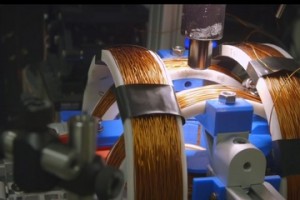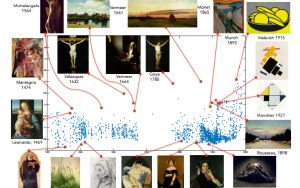For app developers, more big changes are coming soon
The App Store revolutionized the tech world when it opened in summer 2008, spawning a billion-dollar industry in one fell swoop. It was neither the first nor the largest back then, but the store quickly exploded in popularity, prompting Apple co-founder Steve Jobs to say “it is going to be very hard for others to catch up.”
The store was one of the big stars this week at Apple’s annual Worldwide Developers Conference in San Francisco, with CEO Tim Cook’s announcement that it had recently “passed a major milestone, with 100 billion app downloads” since the store opened its virtual doors.
Many in the app-developer fold say the business, thanks to the marketplace created by the App Store and other outlets like Google Play, is still in its infancy and mobile apps in the next few years will continue to change human behavior in unimaginable ways.
From the “Internet of Things,” where apps will help connect an estimated 50 billion devices to the Internet by 2020 and transform the way we relate to our homes and workplaces, to the continued democratization of software, where tech novices will be able to build their own apps, the digital landscape will shift at a breakneck speed.
At the same time, the way apps come into being could also go through a seismic shift. The small independent app-makers who early on helped make the App Store the success it is today will find it harder to survive there, while large corporations will dominate the stage as their in-house coders custom-tailor more and more apps to meet their customers’ needs.
“We’re seeing big companies taking over” the mobile-app industry, said Mark Wilcox, a business analyst with VisionMobile. As a result, according to the firm’s recent survey, nearly half of the developers who want to make money building apps actually make zero or next to nothing. “Large companies, and especially game publishers, take all the top spots on the App Store and most of the revenue,” he said. “The little guys are struggling to compete.”
Calling the momentum “absolutely staggering,” Cook told developers this week that the App Store has forever changed the way we think of software and the way we all increasingly use it in our daily lives.
Connecting everyday objects, from home-heating systems to toasters, will continue to be a major focus for developers, with one survey showing that 53 percent of respondents said they were already working on so-called IoT – or “Internet of Things” – apps. Wearable tech, like the new Apple Watch, could host thousands of new apps this year alone, from health and fitness monitors to tools not yet envisioned.
In a clear nod to the future of apps already unfolding on wearable technology, Cook used his keynote address to introduce Kevin Lynch, Apple’s vice president for technology, to talk about watchOS 2, the first major update for the Apple Watch since it was unveiled last September. Lynch said developers could soon use the new software to build native, or in-watch, apps that would allow users to tap directly into the watch’s burgeoning bounty without having to rely on their iPhones for access.
Another budding trend features strategically placed beacons, small devices in the physical world that interact with apps, which in turn will collect and process mountains of data. An in-app sale offer triggered on your phone by a beacon inside the Wal-Mart you just entered is an example of this technology. Over time, all that data collected from our phones about our daily patterns will then guide and improve the software we’ll use to work and play.
“The ‘Internet of Things’ is happening quickly,” said 22-year-old Ashu Desai, whose Make School is teaching college and high-school students how to build apps. “We’ll see apps where your phone will know more and more about your surroundings. There will be a massive proliferation of sensors that will be everywhere so apps can send you the temperature of your hot tub, lock and unlock your doors, and turn on your stove remotely.”
In a way, the future of apps is already here, with an increasing number of them not on public view at the App Store but quietly being harnessed by teams within private companies and organizations, from giants like Salesforce to stage crews at musical venues to small enterprises like contractors and electricians.
Consultant Richard Carlton helps companies use programs like Apple-owned FileMaker to create their own proprietary apps that allow colleagues to collaborate on a shared database they can all access from their mobile devices.
“These mobile tools allow people who aren’t coders to build their own solutions and share them with their fellow employees,” he said. “For example, we’ve helped plumbers create apps they can use to update their work schedules on their phones. This software lets you sign contracts in the field, take photos and enter them in a database, or do property inspections. And this costs the company a quarter of what they’d pay to have a professional app developer do it.”
In other trends in the coming year, there will be more video ads playing on our smartphone screens, more crowdfunding to launch app startups and more developers leaving Google and Apple to become consultants who’ll build apps for corporate clients like The Home Depot.
“Every company out there is turning to mobile, whether it’s retail or airlines or real estate,” said Shravan Goli, president of the tech-jobs site Dice.com. With big companies storming into the market, the coming years will be tough for the independents, said Craig Hockenberry with app-design firm The Icon Factory.
“The people who want to survive solely off the puzzle game or the camera app are the ones having a problem right now,” he said. “When the App Store opened, our first app sold well because there wasn’t a lot of competition. We were a big fish in a small pond. Now the pond is more like an ocean.”
—-
WHAT’S the future of apps?
We asked five attendees at Apple’s annual Worldwide Developers Conference this week in San Francisco for their take on what’s ahead.
Jenna Hoffstein
Educational app developer, Boston
“We’ll see a broader use of apps in schools, supporting teachers and giving kids more engaging ways to learn math and science.”
Ashok Ramamoorthy
Product manager, India
“All your business will develop around your (enterprise) app. If you’re not taking advantage of that, you’re losing money.”
Igor Ievsiukov
Developer, Ukraine
“Apps will be smarter and they’ll distract the user less. Their functions will be more personalized and personalized more precisely.”
Amy Wardrop
Digital product manager, Sydney
“The future of apps is all about experiential, the actual experience of being human. Wearable health and fitness devices, for example, will provide personal analytics, with more layering of information from both humans and their environment.”
Ashish Singh
Developer, India
“Apps will become part of every aspect of our lives, with virtual-reality apps more prevalent. With an app and a pair of VR glasses, you’ll be able to virtually tour a property for sale, museums or vacation destinations.”
References:http://phys.org/



